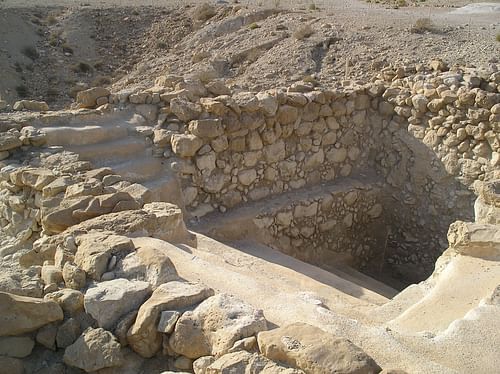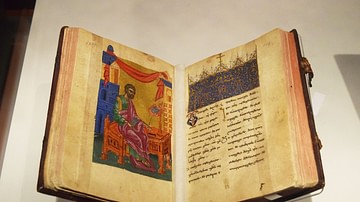New Testament studies now place Jesus Christ within the parameters of Second Temple Judaism in the 1st century CE, attempting to go behind the layers of later Christian theology and philosophy (such as the trinity) to understand how his message would have been received in the towns and villages of Galilee. Misunderstandings and biased views, however, remain inherent in modern conclusions.

There is a consensus among New Testament scholars that Jesus opposed the Temple and temple rituals, teaching a compassionate, egalitarian way of life instead. In his ministry, he challenged the concepts of the Law of Moses, particularly the purity rituals, as leading to distinctions and divisions of economic classes and gender. When Jesus forgave sins in his ministry without the temple rituals and sacrifices or 'atonement', it was his way of demonstrating that the system was no longer valid. Eating with the poor, with outcasts and sinners, eating with women and tax collectors (Gentiles), touching and healing a leper, a hemorrhaging woman all showed his contempt for the system. When he got to Jerusalem, he confronted the seat of this evil at the Temple complex, predicting its destruction. The Temple symbolized the economically and socially oppressive system that Jesus sought to undermine.
Impurity
The book of Leviticus detailed the distinctions between pure and impure, clean and unclean. These are states of being, in relation to sacred space (the Temple). All ancient religions had purity codes when offering sacrifices at a temple. In Judaism, certain elements of daily life rendered people impure for a stated amount of time: menstruation, childbirth, the discharge of semen, corpse contamination. People were then rendered clean at the conclusion of a set time and a sacrifice or ritual washing.
These codes were conceptualized as a way in which to distinguish the sacred from the profane (mundane). This was particularly important in connections to blood and semen. Blood and semen were considered the sources of life, given by God. Hence their involvement meant ritually separating from the normal functions of life for a set time. A menstruating woman could not cook or perform daily routines for a week. She was restored to normalcy after ritual ablutions.
Ritual impurity did not render a person a sinner. The codes addressed aspects of life that had nothing to do with individual sin but were unavoidable aspects of living. When a parent died in the home, corpse contamination could not be avoided. Importantly, the purity codes were only relative to entering the sacred space of the Temple. But no priests or officials checked for this at the entrance to the Temple. Then (as now), most of these codes were self-monitoring in Judaism.
The book of Leviticus is an idealized manual that dictates the necessary behavior in relation to maintaining the holiness of the land of Israel. Historically, however, it remains difficult to determine how much of it was literally performed. Thousands of Jews lived in cities throughout the Roman Empire. While Leviticus detailed the methods of reconciling ritual purity with the sacrificial system, we have little information on how this was accomplished in the provinces. Jewish synagogues were the equivalent to community centers, but not rendered sacred space. The 1st-century CE Jewish philosopher, Philo, writing about the Jewish community in Alexandria, Egypt, mentioned some ritual sprinklings, but without detail. We do have evidence of ritual washing cisterns (mikvah) below the Temple Mount, in the houses of Pharisees, and connected to synagogues. For those Jews who never made it to the Temple in Jerusalem, apparently, there were measures to somehow conform.
Economic Class, Gender, & Gentiles
Purity codes did not distinguish between class or gender roles. All Jews were held to the same codes, the aristocrats as well as the peasants, men as well as women. As women were involved with blood during menstruation and childbirth, men were rendered unclean in the discharge of semen. However, these purity codes were only for Jews; Gentiles (non-Jews) were never expected to follow them. The largest court in the Temple complex was the Court of the Gentiles. Gentiles were welcome to offer their sacrifices which were handed over to Jewish men and then to the priest. Jesus did not contract contamination when he ate or met with Gentiles.
There were no oppressive purity codes against economic classes. In fact, economics was built into the system in the sense of permitting different levels of sacrifices based upon income. If you could not afford a lamb or goat, you could do the same ritual with birds; if you could not afford birds, then a handful of flour or even a handful of grain.
The Temple Incident
The consensus that Jesus opposed the Temple and its system is drawn from the story of the Temple Incident, first reported by Mark (c. 70 CE). Mark reported that the day after his entrance to Jerusalem, he went to the Temple Mount:
On reaching Jerusalem, Jesus entered the temple courts and began driving out those who were buying and selling there. He overturned the tables of the money changers and the benches of those selling doves, and would not allow anyone to carry merchandise through the temple courts. And as he taught them, he said, "Is it not written: 'My house will be called a house of prayer for all nations'? But you have made it 'a den of robbers.'" The chief priests and the teachers of the law heard this and began looking for a way to kill him, for they feared him, because the whole crowd was amazed at his teaching. (Mark 11:15-18).
At the southern end of the Temple Mount was an area known as Solomon’s porch, an arcade area. Once you climbed up the steps from the doors below, this was the area you first encountered on the platform, where the animal-sellers and money changers were located. Scholars place this incident in this arcade.
The Temple in Jerusalem was similar to all temples in the ancient world in that the basis for its operation was the sacrifices of animals, food, and wine libations, but Judaism also emphasized that sacrificial animals had to be without blemish. If you were a Jewish pilgrim coming from one of the provinces to Jerusalem for the festival, you would not drag your sheep or goat all that distance, as it could be blemished by the time you got there. All temples had special farms outside the cities for the raising of these animals. In Jerusalem, the animals were kept in pens down below the Temple Mount and brought up to Solomon’s porch where priests could examine them for sale as a convenience for pilgrims.

Coins in the 1st century CE had portraits of either provincial client-kings or images of the Roman emperor. Judaism had a ban against all images and so Jews could not carry these coins into the Temple area. The money changers were there to exchange them for the Israeli shekel. At the same time, adult Jewish men voluntarily contributed to the maintenance of the Temple through a tax or a donation of a half-shekel each year. This tax was exchanged and paid at the tables of the money changers as well.
The animal-sellers and the money changers collected a fee for their services (as did priests in all temples). There were no government salaries for these people, so this was how they made their living. There is absolutely no historical evidence that either the animal-sellers or the money changers were gauging people or ripping them off. Mark has conflated two quotes from the Prophets Isaiah and Jeremiah, with the "den of thieves" line. The problem is that we always focus on the word, 'thieves' and not the entire phrase. A den of thieves is a hideout where thieves go after robbing a place to distribute the loot; no thieving takes place in the den. In other words, a den of thieves is a safe haven for robbers, and this is exactly what both Isaiah and Jeremiah meant by the phrase. Both Prophets castigated Israel for treating the Temple as a safe haven. They claimed that people went to the Temple, did their round of sacrifices, and so assumed that all was forgiven. But Isaiah and Jeremiah claimed that without true repentance in the heart, their sacrifices meant nothing. It is significant that neither Prophet called for the elimination of the sacrifices, only for true repentance as well.
Mark could appropriately tie this speech to the larger theme in his gospel, the repentance of sins in Jesus’ ministry, but he also may have had something else in mind. Mark was writing at the time of the Great Jewish Revolt of 66 CE. The Greek word rendered 'thieves' here is actually lestes, ("bandits"). This was a general term for the Zealot revolutionaries who carried out bandit raids against Roman convoys, leading up to the revolt. The Zealots had invaded the Temple, attacked and slaughtered the priests, and took over for the duration of the revolt. This may be Mark’s criticism of this activity, in that the Temple had become a den of thieves ("bandits").
Was Jesus Anti-Temple?
This is an important question because according to Mark (and then Matthew and Luke), this Temple Incident led directly to the death of Jesus by the Jews. Narratively, there are many problems with the passage detailing the trial and crucifixion of Jesus of Nazareth. During the major pilgrim festivals, the Roman procurator always had to leave Caesarea and move into the Antonia Fortress (on the northwest corner of the Temple Mount) to keep crowd control. The legions of the Roman army literally stood atop the colonnades, looking down on the crowds, to keep an eye out for messianic pretenders who might incite the crowds to revolution.
If Jesus had overturned the tables and drove out the animal-sellers, the legions and the priests would have noticed. The problem is that this passage is followed by the story of Jesus returning to the Temple for the next three days to continue teaching. What are the odds that he would have been permitted to return by either the priests or the legions? But in relation to narrative function, having Jesus teaching in the Temple for the next few days fills in the time from his entrance into the city until the first night of Passover.

Scholars continue to debate the Temple Incident in relation to its historicity. Some are convinced that Jesus did something, while others assign it fully to Mark’s polemic. If the historical Jesus saw himself in the tradition of the Prophets of Israel, this may have been his way of replicating a prophetic gesture. Jeremiah was famous for walking through the Temple Mount and smashing pots all over the place as an indication of the coming destruction of Solomon’s Temple by the Babylonians. Given the time frame, Mark could have utilized the same symbolic activity with Jesus symbolizing the fall of the Temple in 70 CE.
Other scholars analyze the problem that throughout Mark's gospel, the opposition is always the Pharisees, scribes, elders, lawyers, and Herodians. There is no mention of the Sadducees or Rome, but knowing how Jesus died, Mark had to get Jesus to the attention of both the priests and the Roman legions. The Temple Incident would bring Jesus to the attention of both the Sadducees and the Roman government.
For the gospel writers, the anti-Temple sentiment was the reason for Jesus' death, but problems remain:
- If Jesus was anti-Temple, this did not violate the Law of Moses in any way, nor did it carry a death penalty. Different sects of Jews (Essenes, Pharisees, Zealots) in the 1st century CE always criticized the Sadducees and their running of the Temple. Their level of polemic was even harsher than the gospels. However, no messianic contender or any Pharisee was ever executed for this.
- Both before and after the writing of the gospels, we can find no early traditions that Jesus was against the Temple.
Writing within 20 years of the death of Jesus, Paul’s letters contain nothing but praise for the Temple and its institutions as the glory of Israel. From these letters, it is apparent that Paul knew nothing about an anti-Temple tradition in the ministry of Jesus. Written by the same author of the third gospel, Luke, c. 95 CE, the Acts of the Apostles contains stories of the first Christian believers in Jerusalem. Luke related that Peter and John (and the other disciples) continued to go to the Temple every day in praise of God and its institutions. If Jesus had in fact preached against the Temple, it appears that his disciples had no memory of this.
The Polemic of the Gospels
A polemic is a verbal or written attack against an opponent or a different point of view. All of the gospels utilized this literary device to showcase the teachings of Jesus against other points of view, especially that of the Pharisees. Polemic often involves stereotypes of a collective framework in which to detail arguments from both sides. The Pharisees were noted for their daily adherence to the Law of Moses that went above and beyond the practices of other Jews. As such, they became the foil in oppositional debates between Jesus and the current system. But polemic is not evidence. The charge that the Pharisees (and Sadducees) denied salvation to certain groups of Jews cannot be verified historically.
All the gospels were written after the destruction of the Temple complex. This meant that the traditional rituals and sacrifices were rendered null. In describing the ministry of Jesus (40 years earlier), the gospel writers have Jesus predict this destruction while teaching a new way of understanding forgiveness and atonement. Without the Temple, the traditional system of ritual purity and atonement was no longer possible. Jesus’ critique of temple practices in the ministry looks forward to the reason for God permitting the destruction of the Temple.
Unfortunately, a Jesus opposed to Judaism became and remains the basis of centuries of Christian antisemitism. In the Middle Ages, Jews were restricted from most businesses, except loaning money for interest (usury). The charge of money changers at the Temple was consistently applied to Jewish communities as a whole. But theologically, the teachings of Jesus in the gospels provide an insight into the evil institutions of our own culture: class struggles, inequality of gender roles, and racial discrimination.








